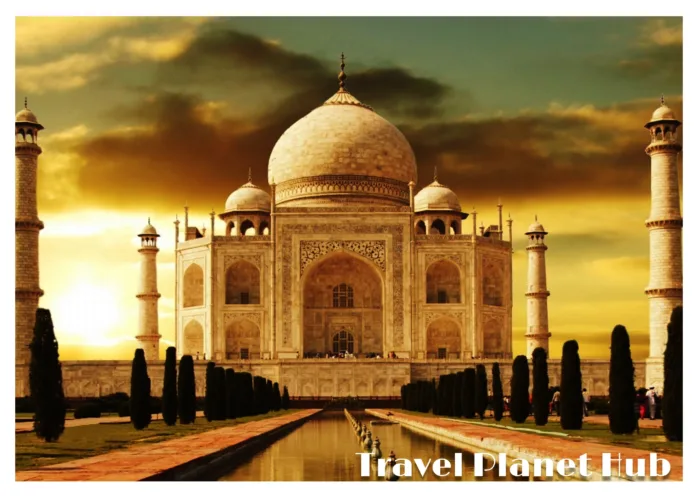Table of Contents
India, a land steeped in history, adorned with a kaleidoscope of cultures, and blessed with awe-inspiring landscapes, has evolved into an irresistible magnet for travelers in search of a truly distinctive and immersive experience. This incredible subcontinent, nestled between the Himalayas in the north and the Indian Ocean in the south, unfolds a captivating tapestry that weaves together tales of ancient civilizations, spiritual wonders, and natural splendors.
At the heart of India’s allure lies its rich history, a captivating narrative that unfolds in architectural marvels and ancient ruins. The iconic Taj Mahal, standing proudly on the banks of the Yamuna River in Agra, epitomizes the grandeur of Mughal architecture and immortalizes the eternal love of Emperor Shah Jahan for his beloved wife Mumtaz Mahal. As you traverse the vast courtyards and intricate chambers, the Taj Mahal unveils not only a historical masterpiece but a timeless symbol of enduring love.
Venturing into the bustling streets of Delhi, travelers are greeted by vibrant markets that pulsate with life and color. From the labyrinthine lanes of Chandni Chowk to the modern elegance of Connaught Place, Delhi’s markets showcase a blend of tradition and contemporary flair. The scents of exotic spices, the vibrant hues of textiles, and the harmonious cacophony of vendors beckon visitors into a sensory journey through India’s cultural bazaar.
As we embark on this exploration, the top 15 tourist attractions will guide us through the diverse tapestry of India’s beauty. Each destination unfolds a unique chapter, adding layers to the narrative of a land that encapsulates centuries of heritage and traditions.
The historic Red Fort in Delhi, a UNESCO World Heritage Site, echoes the bygone era of Mughal emperors. Its grand red sandstone walls and intricate architecture resonate with tales of imperial grandeur, offering visitors a glimpse into the political epicenter of ancient India. The diwan-i-aam and diwan-i-khas, or Halls of Public and Private Audience, narrate stories of governance and regal splendor.
Journeying to Jaipur, the Pink City, unveils the majestic splendor of the Amber Fort. Perched atop the Aravalli Hills, this architectural gem showcases a harmonious blend of Rajput and Mughal styles. The intricate mirror work, expansive courtyards, and panoramic views of Maota Lake create an ambiance that transports visitors to the regal courts of Rajasthan.
Varanasi, the spiritual haven on the banks of the Ganges, offers an immersion into India’s cultural and religious fabric. The ghats, where rituals unfold against the backdrop of ancient temples, represent the eternal cycle of life and death. A boat ride during sunrise reveals a mystical panorama as the sun’s golden rays illuminate the sacred river.
In Amritsar, the Golden Temple, or Harmandir Sahib, stands as a sanctuary of Sikh spirituality. The glistening gold facade mirrored in the Amrit Sarovar offers a tranquil retreat, inviting visitors to partake in the community kitchen’s langar, a symbol of equality and humility.
The tropical paradise of the Andaman and Nicobar Islands invites travelers to pristine beaches, crystal-clear waters, and vibrant coral reefs. Radhanagar Beach, with its powdery white sands and turquoise waters, reflects the untouched beauty of nature.
This journey through India’s top attractions unravels the tapestry of a nation that seamlessly blends tradition and modernity, spirituality and adventure, history and natural wonders. From the cultural kaleidoscope of Delhi to the tropical bliss of the Andaman Islands, each destination contributes to the mosaic that defines India’s allure. As we delve into the intricacies of these attractions, we discover that India is not merely a destination; it is an immersive experience, a journey through time and diverse landscapes that leaves an indelible mark on the hearts of those who explore its treasures.
Taj Mahal: A Timeless Marvel
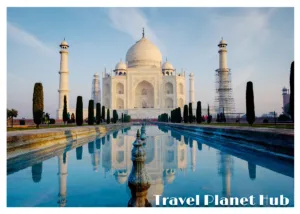
The Taj Mahal, a sublime masterpiece of Mughal architecture, stands proudly on the banks of the Yamuna River in Agra. Commissioned by Emperor Shah Jahan in memory of his beloved wife Mumtaz Mahal, this ivory-white marble mausoleum captivates millions of visitors each year. As you approach through the grand gateway, the sheer grandeur of the Taj Mahal unfolds, leaving spectators awe-struck by its symmetrical beauty and intricate details.
The main mausoleum, crowned by the iconic dome, houses the intricately designed cenotaphs of Shah Jahan and Mumtaz Mahal. The white marble facade undergoes a mesmerizing transformation throughout the day, changing hues with the sunlight. Strolling through the pristine gardens, adorned with reflecting pools and fountains, offers a serene escape, providing a moment of reflection in the shadow of this architectural marvel.
As the sun sets, the Taj Mahal takes on a magical aura during the evening. The monument is beautifully illuminated, casting a romantic glow that enhances its ethereal beauty. The Yamuna River reflects the Taj’s splendor, creating a surreal ambiance. Visiting the Taj Mahal is not just a historical exploration but a journey into the enduring love story that inspired its creation, making it an essential stop for anyone venturing into India.
Jaipur’s Amber Fort: Majestic Splendor
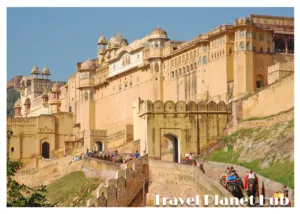
Perched majestically on the Aravalli Hills, the Amber Fort in Jaipur offers a captivating blend of Rajput and Mughal architectural styles. Its imposing ramparts, adorned with intricate carvings and mirror work, invite visitors to step back in time to the era of Maharajas and royal opulence. As you ascend the fort on an elephant or by Jeep, the panoramic views of the surrounding hills and Maota Lake create a mesmerizing backdrop.
The fort’s interiors are a testament to Rajput grandeur, featuring ornate chambers, halls, and courtyards. The Sheesh Mahal, or Hall of Mirrors, is particularly enchanting, with its walls adorned with thousands of tiny mirrors that glitter like stars. Exploring the various sections of the fort, such as the Diwan-i-Aam and Diwan-i-Khas, provides insights into the administrative and social aspects of the Rajput court.
To fully immerse in the Amber Fort experience, attend the sound and light show in the evening. The fort comes alive with narrations of historical events, accompanied by colorful lights that dance on the walls. The show transports visitors to a bygone era, creating a magical atmosphere that complements the daytime exploration. Amber Fort is not just a historical relic; it’s a living testament to Jaipur’s royal heritage and architectural prowess.
Varanasi: Spiritual Haven on the Ganges
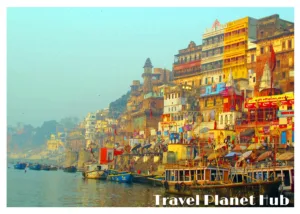
Nestled along the sacred Ganges River, Varanasi is a city that breathes spirituality. The ghats, the steps leading down to the river, buzz with activity as pilgrims perform their rituals and ceremonies. Taking a boat ride along the Ganges during sunrise offers a surreal experience, with the rising sun casting a warm glow on the ancient city and its ghats.
The narrow alleys of Varanasi, known as ‘galis,’ are a maze of colors, sounds, and aromas. Here, you’ll find bustling markets, traditional silk weavers, and street vendors offering an array of local delicacies. The Kashi Vishwanath Temple, dedicated to Lord Shiva, is a sacred pilgrimage site, attracting devotees from across the globe.
The Ganga Aarti, held every evening at the Dashashwamedh Ghat, is a spectacle that shouldn’t be missed. Priests, adorned in saffron robes, perform synchronized rituals with fire lamps, flowers, and chants, creating a mesmerizing display of devotion. Varanasi is not just a destination; it’s a spiritual journey where the sacred and the earthly coexist, leaving a lasting imprint on the hearts of those who seek a profound connection with India’s spiritual heritage.
Golden Temple, Amritsar: A Sikh Sanctuary
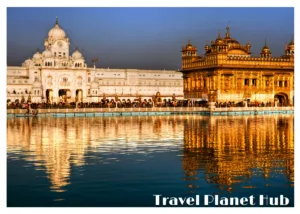
The Golden Temple, also known as Harmandir Sahib, stands as a beacon of spiritual tranquility in the heart of Amritsar. As you approach the temple complex, the shimmering gold facade reflects in the surrounding Amrit Sarovar, creating an awe-inspiring sight. The architectural brilliance of the temple, adorned with intricate details and glistening domes, is a testament to Sikh craftsmanship and devotion.
The serene atmosphere inside the Golden Temple is heightened by the continuous recitation of the Guru Granth Sahib, the holy scripture of Sikhism. Visitors are welcomed with open arms, irrespective of their background, to partake in the langar, a community kitchen serving free meals to thousands daily. The communal dining experience promotes equality and reflects the core principles of Sikhism.
The nightly Palki Sahib ceremony, where the Guru Granth Sahib is carried to its resting place, is a captivating ritual that draws devotees and tourists alike. The Golden Temple’s reflection in the Amrit Sarovar during the nighttime is a sight to behold, symbolizing spiritual enlightenment and tranquility. Amritsar’s Golden Temple is not merely a religious site; it is a living embodiment of Sikh values, hospitality, and the pursuit of inner peace.
Kerala Backwaters: Serenity in Nature’s Lap
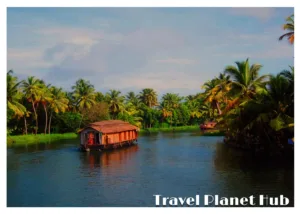
Embark on a journey through the enchanting backwaters of Kerala, where interconnected rivers, lakes, and canals create a mesmerizing labyrinth of waterways. The traditional houseboat ride is the perfect way to experience the tranquil beauty of the region. Surrounded by lush greenery and palm-fringed landscapes, travelers can unwind and immerse themselves in the serenity of nature.
The backwaters are not just a visual delight; they are a window into the lives of the local communities. Passing by quaint villages, you’ll witness everyday activities like fishing, coir making, and paddy cultivation. Friendly locals often wave from the shores, adding a touch of warmth to the serene environment.
Kerala’s backwaters also offer opportunities for cultural experiences. Visiting a traditional Kerala home, exploring local markets, and savoring authentic cuisine onboard the houseboat contribute to a holistic understanding of the region’s lifestyle. Whether you’re seeking relaxation, cultural enrichment, or a romantic getaway, the Kerala backwaters provide a unique and immersive travel experience.
Rishikesh and Haridwar: Spiritual Adventure
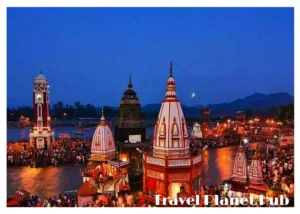
Nestled in the Himalayan foothills, the twin cities of Rishikesh and Haridwar are synonymous with spirituality, adventure, and a deep connection to the Ganges River. Rishikesh, known as the ‘Yoga Capital of the World,’ offers a serene escape for yoga enthusiasts and spiritual seekers. The ghats along the Ganges provide the perfect setting for meditation, yoga, and spiritual contemplation.
For the adventure seekers, Rishikesh is a gateway to thrilling activities like white-water rafting and trekking in the nearby Himalayan trails. The iconic Lakshman Jhula and Ram Jhula bridges, suspended over the Ganges, offer breathtaking views of the river and the surrounding hills. The evening Ganga Aarti in Haridwar, with its rhythmic chants and synchronized rituals, is a soul-stirring experience that lingers in the hearts of those who witness it.
Both Rishikesh and Haridwar offer a blend of spirituality and adventure, making them unique destinations where visitors can rejuvenate their souls, embark on thrilling escapades, and witness the divine beauty of the Ganges River amid the majestic Himalayan landscape.
Delhi’s Historic Red Fort: Echoes of the Past
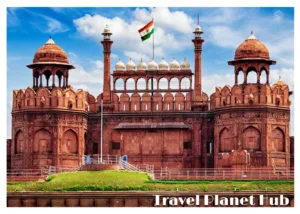
Delhi, the capital city, boasts a rich historical legacy, and at its heart lies the iconic Red Fort. Constructed during the Mughal era, this UNESCO World Heritage Site is a testament to the grandeur of Mughal architecture. Stepping through the Lahore Gate, visitors are transported to a bygone era where emperors held court, and the fort served as the center of political power.
The sprawling complex houses numerous structures, each with its own historical significance. The Diwan-i-Aam, or Hall of Public Audience, witnessed the emperor addressing the masses, while the Diwan-i-Khas, or Hall of Private Audience, hosted private meetings and discussions. Exploring the intricately designed Rang Mahal and the ornate Hammam provides a glimpse into the luxurious lifestyle of the Mughal rulers.
In the evening, the sound-and-light show narrates the history of the Red Fort, using captivating visuals and dramatic storytelling. The illuminated fort against the night sky creates a magical ambiance, allowing visitors to witness the historical saga come to life. Delhi’s Red Fort stands as a living testament to the city’s glorious past, offering an immersive experience for history enthusiasts and curious travelers alike.
Goa’s Pristine Beaches: Sun, Sand, and Seafood

Goa, with its vibrant mix of Portuguese heritage and Indian culture, is renowned for its pristine beaches that stretch along the Arabian Sea. Each beach has its own charm and atmosphere, catering to a diverse range of visitors. Baga Beach is famous for its lively nightlife, water sports, and shacks serving delectable seafood, while Palolem Beach offers a more relaxed and tranquil setting.
The beaches of Anjuna and Vagator are popular among backpackers and party enthusiasts, hosting vibrant beach parties and flea markets. For those seeking solitude, the quieter beaches of Agonda and Morjim provide a serene escape, surrounded by palm groves and offering a chance to witness nesting sea turtles.
Apart from the sun, sand, and sea, Goa’s beaches offer a myriad of activities. From water sports like parasailing and jet-skiing to exploring the historic forts along the coastline, visitors can choose their own adventure. Goa’s beaches are not just a destination for sunbathing; they are a vibrant tapestry of experiences, capturing the essence of relaxation, adventure, and cultural fusion.
Khajuraho Temples: Architectural Marvels
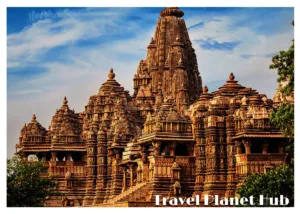
In the heart of Madhya Pradesh, the Khajuraho Group of Monuments stands as a testament to the artistry and craftsmanship of the Chandela dynasty. The intricately carved temples, designated as a UNESCO World Heritage Site, showcase a stunning blend of Hindu and Jain architecture. The sculptures depict various facets of life, love, and spirituality, providing a unique insight into the cultural ethos of medieval India.
Each temple at Khajuraho tells a story, with the Western Group housing the renowned Lakshmana Temple, dedicated to Lord Vishnu, and the Eastern Group featuring the revered Jain temples. The erotic sculptures, although just a small fraction of the overall carvings, have garnered global attention for their explicit detail and artistic expression.
Exploring the temples during the day allows visitors to appreciate the intricate details of the carvings, each telling a story from mythology or daily life. As the sun sets, a sound-and-light show narrates the history of Khajuraho, adding a mystical ambiance to the ancient ruins. Khajuraho’s temples are not just architectural marvels; they are a journey through time, offering a glimpse into the artistic brilliance of India’s medieval period.
Hampi’s Ruins: A Walk Through History
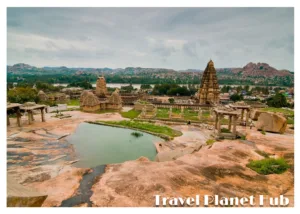
The ruins of Hampi, a UNESCO World Heritage Site, unfold like an open-air museum amidst the rugged landscapes of Karnataka. Once the capital of the Vijayanagara Empire, Hampi boasts a vast complex of temples, bazaars, and royal enclosures that transport visitors to a bygone era. The Virupaksha Temple, dedicated to Lord Shiva, stands as a living testament to the city’s former glory.
Exploring the ruins allows travelers to witness the grandeur of the Vijayanagara architecture, characterized by intricate carvings, colossal boulders, and majestic structures like the Vitthala Temple. The stone chariot, a symbolic centerpiece, is a prime example of the architectural ingenuity that defines Hampi.
The ancient bazaar, known as Hampi Bazaar, was once a thriving marketplace, and today, its weathered remnants echo the commercial activity that once flourished within its walls. Crossing the Tungabhadra River to the other side unveils the Lotus Mahal and the Elephant Stables, offering a glimpse into the royal lifestyle.
As the sun sets over the Hampi ruins, the landscape transforms into a surreal panorama. The boulders cast long shadows, and the monuments stand silhouetted against the twilight sky. For history enthusiasts, photographers, and curious wanderers, Hampi’s ruins provide an immersive journey through time, unlocking the mysteries of a lost empire.
Mysore Palace: Royal Grandeur
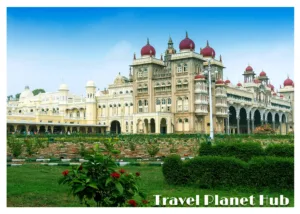
Mysore, often referred to as the ‘Cultural Capital of Karnataka,’ is home to the opulent Mysore Palace, a symbol of royal grandeur. This Indo-Saracenic masterpiece, illuminated by thousands of bulbs during special occasions, stands as a testament to the Wadiyar dynasty’s architectural patronage and cultural legacy.
The sprawling palace complex houses a series of ornate rooms, each adorned with intricate carvings, paintings, and artifacts. The Durbar Hall, with its intricate mosaic flooring and stained glass ceilings, served as the ceremonial hall for grand gatherings and royal events. The private chambers, open to the public, provide a glimpse into the personal lives of the royal family.
The palace is not only a repository of history but also a cultural hub. The annual Mysuru Dasara festival, celebrated with grandeur, marks the palace as the epicenter of the city’s festivities. Visitors can witness the royal procession, cultural performances, and the illumination of the palace during this vibrant ten-day celebration.
Mysore Palace’s architectural splendor and cultural significance make it a must-visit destination for those seeking a glimpse into Karnataka’s royal heritage. Whether during the day, when the intricate details come to life, or at night, when the palace is bathed in a golden glow, Mysore Palace offers a regal experience that resonates with history and cultural richness.
Ajanta and Ellora Caves: Rock-Cut Wonders
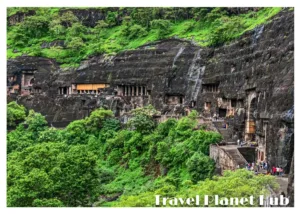
Nestled in the rocky landscapes of Maharashtra, the Ajanta and Ellora Caves present an unparalleled showcase of rock-cut architecture and ancient Indian art. Designated as UNESCO World Heritage Sites, these caves date back to the 2nd century BCE and span various religious traditions, including Buddhism, Hinduism, and Jainism.
The Ajanta Caves, with their intricate paintings and sculptures, are a testament to the artistic brilliance of ancient Indian craftsmen. Each cave tells a story from Buddhist scriptures, creating a narrative tapestry that spans over two centuries. The depiction of the Jataka tales, the life of Buddha, and celestial beings showcases the evolution of artistic styles.
In contrast, the Ellora Caves, numbering 34 in total, encompass Buddhist, Hindu, and Jain temples carved out of solid rock. The Kailasa Temple, dedicated to Lord Shiva, stands as a monolithic marvel, representing a pinnacle of rock-cut architecture. The intricacy of the carvings and the sheer scale of the structures leave visitors in awe of the craftsmanship of the ancient artisans.
Exploring the caves is like embarking on a journey through time and religious diversity. Each cave, with its unique architectural features and religious symbolism, contributes to a comprehensive understanding of ancient India’s cultural and religious tapestry. Ajanta and Ellora, hidden wonders in the heart of Maharashtra, beckon travelers to witness the legacy of a bygone era.
Darjeeling: Tea Gardens and Mountain Views
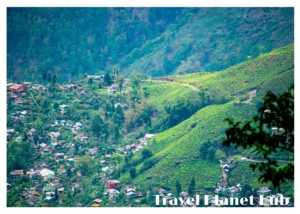
Nestled in the Eastern Himalayas, Darjeeling is a quaint hill station renowned for its tea gardens, panoramic mountain views, and a charming blend of British colonial and Tibetan cultures. The sprawling tea estates, like the iconic Happy Valley Tea Estate, offer visitors a chance to witness the intricate process of tea cultivation, plucking, and processing.
The Darjeeling Himalayan Railway, a UNESCO World Heritage Site, adds to the town’s colonial charm. The toy train, with its narrow gauge, winds through the picturesque landscapes, offering breathtaking views of the mountains and valleys. The Batasia Loop, a unique spiral railway track, provides a vantage point for capturing the beauty of the surrounding hills.
Apart from the tea plantations and the charming railway, Darjeeling boasts cultural diversity. The Mahakal Temple, dedicated to Lord Shiva, and the Peace Pagoda, a symbol of world peace, reflect the town’s spiritual side. The vibrant markets, showcasing Tibetan handicrafts and local produce, offer a glimpse into Darjeeling’s cultural tapestry.
For nature enthusiasts and adventure seekers, Darjeeling offers trekking opportunities in the nearby Singalila National Park, providing stunning views of the Himalayan range, including the majestic Kanchenjunga. Whether you’re sipping tea in a colonial-era teahouse, riding the toy train, or trekking through the lush landscapes, Darjeeling promises a tranquil escape amidst the Himalayan beauty.
Udaipur’s City Palace: Romantic Retreat
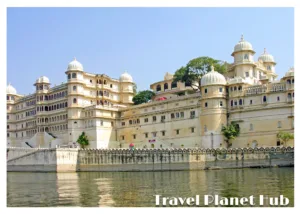
Udaipur, often referred to as the ‘City of Lakes,’ is adorned with the regal City Palace, a complex that stands on the banks of Lake Pichola. This architectural marvel, a fusion of Rajasthani and Mughal styles, offers panoramic views of the city, the lake, and the surrounding Aravalli hills. As you explore the palace, each courtyard, terrace, and chamber unfolds a narrative of Udaipur’s royal history.
The Mor Chowk, or Peacock Courtyard, showcases mesmerizing glass and mirrorwork, while the Sheesh Mahal, or Palace of Mirrors, provides a celestial setting with its reflective surfaces and intricate detailing. The Mardana Mahal, dedicated to the royal men, and the Zenana Mahal, the palace for the royal women, offer insights into the regal lifestyle.
The City Palace is not just a historical monument; it serves as a testament to the enduring romance of Udaipur. The Lake Palace, nestled on Jag Niwas Island in Lake Pichola, is part of the City Palace complex and has earned fame for its picturesque setting and luxurious ambiance. Sunset boat rides on Lake Pichola, offering views of the illuminated City Palace, add a touch of magic to the romantic allure of Udaipur.
Andaman and Nicobar Islands: Tropical Paradise

For an exotic tropical getaway, the Andaman and Nicobar Islands beckon with their pristine beaches, crystal-clear waters, and vibrant coral reefs. Radhanagar Beach, known for its powdery white sands and turquoise waters, is a haven for beach lovers, offering a tranquil escape amid nature’s splendor. The Neil Island, with its natural rock formations and diverse marine life, is a paradise for snorkeling enthusiasts.
The Cellular Jail in Port Blair, a poignant symbol of India’s struggle for independence, adds a touch of history to the islands. The light-and-sound show at the Cellular Jail narrates the stories of the freedom fighters who were once imprisoned within its walls, creating a solemn yet enlightening experience for visitors.
For adventure seekers, the Andaman and Nicobar Islands offer thrilling water activities. Snorkeling at North Bay Island, scuba diving in Havelock Island, and exploring the vibrant coral reefs at Mahatma Gandhi Marine National Park provide a unique underwater perspective of the islands’ biodiversity.
The islands also hold cultural diversity, with indigenous tribes like the Jarawas and the Great Andamanese adding to the region’s rich heritage. The Andaman and Nicobar Islands are not just a tropical paradise; they are a mosaic of experiences, blending natural beauty, historical significance, and cultural diversity to create a destination that caters to every traveler’s desires.
Conclusion: Exploring the Mosaic of India
India, with its top-rated tourist attractions, offers a kaleidoscope of experiences for travelers seeking history, spirituality, adventure, and natural beauty. From the architectural marvels like the Taj Mahal and the cultural richness of Mysore Palace to the serene backwaters of Kerala and the tropical paradise of the Andaman Islands, each destination encapsulates a unique facet of India’s diverse landscapes and vibrant heritage.
As you traverse the country, you’ll witness the echoes of the past in historic forts, explore the intricacies of rock-cut wonders, and immerse yourself in the spiritual ambiance of ancient cities. India’s allure lies in its ability to captivate the senses, offering a journey that transcends time and space.
FAQs:
- Q: Is it safe to travel to India?
- A: Yes, with proper precautions and awareness, India is generally safe for tourists. It’s essential to stay informed about local customs and follow travel advisories.
- Q: What is the best time to visit the Taj Mahal?
- A: The best time is during the winter months (October to March) when the weather is pleasant, and the monument is beautifully illuminated.
- Q: Are the Andaman and Nicobar Islands suitable for family vacations?
- A: Absolutely! The islands offer a perfect blend of relaxation and adventure, suitable for families seeking a tropical paradise.
- Q: How can I explore the backwaters of Kerala?
- A: Houseboat tours are the most popular way to experience the Kerala backwaters. You can hire a private houseboat for a personalized journey.
- Q: Are there guided tours available for the Ajanta and Ellora Caves?
- A: Yes, local guides are available at the caves to provide insightful information and enhance your understanding of the historical significance.
